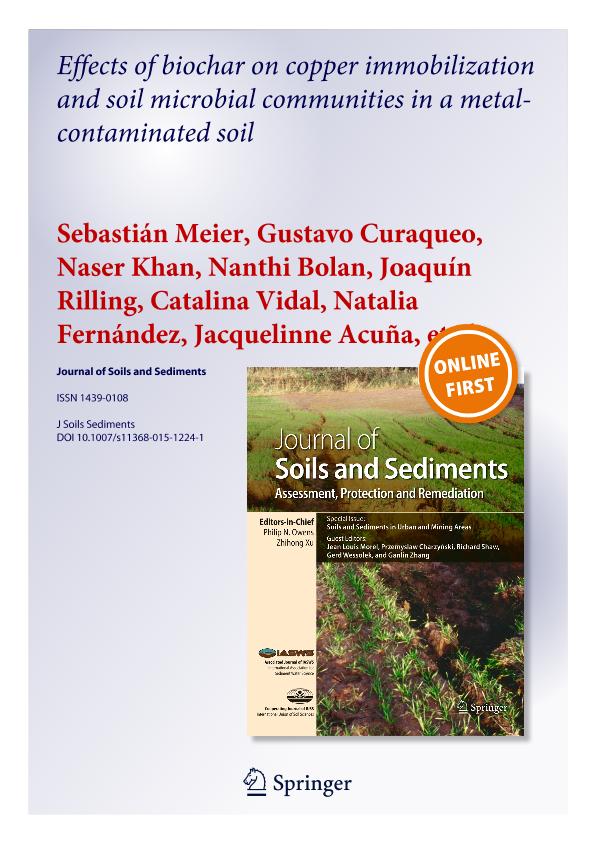Mostrar el registro sencillo del ítem
dc.contributor.author
Meier, Sebastián
dc.contributor.author
Curaqueo, Gustavo
dc.contributor.author
Khan, Naser
dc.contributor.author
Bolan, Nanthi
dc.contributor.author
Rilling, Joaquín
dc.contributor.author
Vidal, Catalina
dc.contributor.author
Fernández, Natalia Verónica

dc.contributor.author
Acuña, Jacquelinne
dc.contributor.author
González, María Eugenia

dc.contributor.author
Cornejo, Pablo
dc.contributor.author
Borie, Fernando
dc.date.available
2017-01-31T19:41:01Z
dc.date.issued
2015-06
dc.identifier.citation
Meier, Sebastián; Curaqueo, Gustavo; Khan, Naser; Bolan, Nanthi; Rilling, Joaquín; et al.; Effects of biochar on copper immobilization and soil microbial communities in a metal-contaminated soil; Springer Heidelberg; Journal Of Soils And Sediments (print); 6-2015; 1-14
dc.identifier.issn
1439-0108
dc.identifier.uri
http://hdl.handle.net/11336/12263
dc.description.abstract
Purpose: Copper (Cu) contamination has been increasing in land ecosystems. Biochars (BCs) and arbuscular mycorrhizal fungi (AMF) are known to bind metals, and metallophyte can remove metals from soils. Will BC in combination with AMF contain the Cu uptake by a metallophyte growing in a metal-contaminated soil? The objective of this study was to investigate the effects of BCs on the Cu immobilization and over soil microbial communities in a metal-contaminated soil in the presence of AMF and metallophyte.
Materials and methods: Two BCs were produced from chicken manure (CMB) and oat hull (OHB). A Cu-contaminated sandy soil (338 mg kg−1) was incubated with CMB and OHB (0, 1, and 5 % w/w) for 2 weeks. Metallophyte Oenothera picensis was grown in pots (500 mL) containing the incubated soils in a controlled greenhouse for 6 months. A number of analyses were conducted after the harvest. These include plant biomass weight, microbial basal respiration, and dehydrogenase activity (DHA), AMF root colonization, spore number, and glomalin production; changes in fungal and bacterial communities, Cu fractions in soil phases, and Cu uptake in plant tissues.
Results and discussion: The BCs increased the soil pH, decreased easily exchangeable fraction of Cu, and increased organic matter and residual fraction of Cu. The BCs provided favorable habitat for microorganisms, thereby increasing basal respiration. The CMB increased DHA by ∼62 and ∼574 %, respectively, for the low and high doses. Similarly, the OHB increased soil microbial activity by ∼68 and ∼72 %, respectively, for the low and high doses. AMF root colonization, spore number, and total glomalin-related soil protein (GRSP) production increased by ∼3, ∼2, and ∼3 times, respectively, in soils treated with 1 % OHB. Despite being a metalophyte, O. picensis could not uptake Cu efficiently. Root and shoot Cu concentrations decreased or changed insignificantly in most BC treatments.
Conclusions: The results show that the BCs decreased bioavailable Cu, decreased Cu uptake by O. picensis, improved habitat for microorganisms, and enhanced plant growth in Cu-contaminated soil. This suggests that biochars may be utilized to remediate Cu-contaminated soils.
dc.format
application/pdf
dc.language.iso
eng
dc.publisher
Springer Heidelberg

dc.rights
info:eu-repo/semantics/openAccess
dc.rights.uri
https://creativecommons.org/licenses/by-nc-sa/2.5/ar/
dc.subject
Arbuscular Mycorrhizal Fungi
dc.subject
Biochar
dc.subject
Copper Immobilization
dc.subject
Microorganisms
dc.subject
Contamination
dc.subject.classification
Bioremediación, Diagnóstico Biotecnológico en Gestión Medioambiental

dc.subject.classification
Biotecnología del Medio Ambiente

dc.subject.classification
INGENIERÍAS Y TECNOLOGÍAS

dc.subject.classification
Biología Celular, Microbiología

dc.subject.classification
Ciencias Biológicas

dc.subject.classification
CIENCIAS NATURALES Y EXACTAS

dc.subject.classification
Conservación de la Biodiversidad

dc.subject.classification
Ciencias Biológicas

dc.subject.classification
CIENCIAS NATURALES Y EXACTAS

dc.title
Effects of biochar on copper immobilization and soil microbial communities in a metal-contaminated soil
dc.type
info:eu-repo/semantics/article
dc.type
info:ar-repo/semantics/artículo
dc.type
info:eu-repo/semantics/publishedVersion
dc.date.updated
2016-12-12T14:23:01Z
dc.identifier.eissn
1614-7480
dc.journal.pagination
1-14
dc.journal.pais
Alemania

dc.journal.ciudad
Heidelberg
dc.description.fil
Fil: Meier, Sebastián. Universidad de la Frontera. Núcleo Científico y Tecnológico en Recursos Naturales; Chile
dc.description.fil
Fil: Curaqueo, Gustavo. Universidad de la Frontera. Núcleo Científico y Tecnológico en Recursos Naturales; Chile
dc.description.fil
Fil: Khan, Naser. University of South Australia; Australia
dc.description.fil
Fil: Bolan, Nanthi. University of South Australia; Australia
dc.description.fil
Fil: Rilling, Joaquín. Universidad de la Frontera. Núcleo Científico y Tecnológico en Recursos Naturales; Chile
dc.description.fil
Fil: Vidal, Catalina. Universidad de la Frontera. Núcleo Científico y Tecnológico en Recursos Naturales; Chile
dc.description.fil
Fil: Fernández, Natalia Verónica. Universidad Nacional del Comahue. Centro Regional Universidad de Bariloche. Departamento de Biologia. Laboratorio de Microbiologia Aplicada y Biotecnologia; Argentina. Consejo Nacional de Investigaciones Científicas y Técnicas. Centro Científico Tecnológico Patagonia Norte. Instituto de Investigación en Biodiversidad y Medioambiente; Argentina
dc.description.fil
Fil: Acuña, Jacquelinne. Universidad de la Frontera. Núcleo Científico y Tecnológico en Recursos Naturales; Chile
dc.description.fil
Fil: González, María Eugenia. Universidad Católica de Temuco; Chile
dc.description.fil
Fil: Cornejo, Pablo. Universidad de la Frontera. Núcleo Científico y Tecnológico en Recursos Naturales; Chile
dc.description.fil
Fil: Borie, Fernando. Universidad de la Frontera. Núcleo Científico y Tecnológico en Recursos Naturales; Chile
dc.journal.title
Journal Of Soils And Sediments (print)

dc.relation.alternativeid
info:eu-repo/semantics/altIdentifier/doi/http://dx.doi.org/10.1007/s11368-015-1224-1
dc.relation.alternativeid
info:eu-repo/semantics/altIdentifier/url/http://link.springer.com/article/10.1007%2Fs11368-015-1224-1
Archivos asociados
